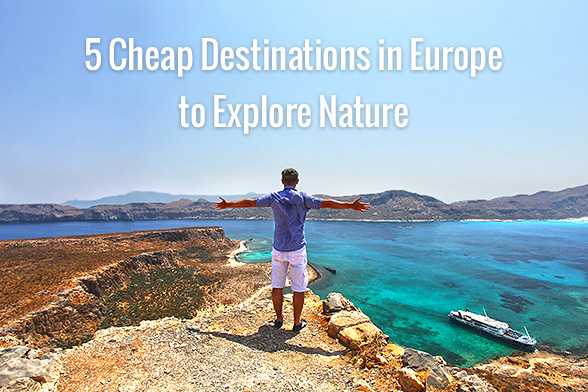5 Cheap Destinations in Europe to Explore Nature

If you’re on a budget, but still feel in need of a break this year, why not try one of these destinations?
1. Dubrovnik Coastline, Croatia
A UNESCO World Heritage Site since 1979, Dubrovnik was described as “the Pearl of the Adriatic” by George Bernard Shaw. The city’s best feature is its pedestrian-only Old Town, containing countless historic sites, including the well-preserved city walls along which you can walk; and spend inexpensive days on the beautiful pebbled beaches within easy reach of the city. And the many guided local tours allow you to discover hidden places and to try adventures you never thought of.
You can pick up flights from various low-cost companies that fly there; and take advantage of the shuttle bus that runs between the airport and the city – much cheaper than a taxi.
2. Greek Islands
The key to budget travel in Greece is flexibility: you can pick up a less expensive flight if you have a range of dates you can travel on.
Once there, it’s generally cheaper to travel between islands by the slower ferry than by flying. And if you turn up on an island without having booked your accommodation, you can be sure there will be hotel and apartment owners willing to negotiate a good price if you’re prepared to haggle. As the summer season comes to an end, island economies are likely to be far cheaper.
3. Faroe Islands, Denmark
The Faroe Islands are a self-governing nation within the Kingdom of Denmark, roughly halfway between Scotland and Iceland. These 18 rocky, rugged volcanic islands rise out of the Atlantic and strange to say there are no major lakes, rivers or even trees, but with 1,117 km (694 miles) of coastline, it is rich in sea birds and offers some of Europe’s best-value hiking and bird watching.
Helicopters and boats provide a convenient shuttle service between the island, and these are subsidized by the Faroese government, making it cheap to get around and enjoy exceptional walking without crowds.
4. Babia Góra National Park, Poland
Though not as inexpensive as it used to be, Poland has much to offer the budget traveler. If you’re a devotee of outdoor activities, make your way to Babia Góra National Park, a UNESCO Biosphere Reserve. It’s about 90 km south-west of Krakow and consists of mountainous, forested terrain with Babia Góra its highest summit (1,725 metres above sea level).
Day entrance to the park is €1.5 and overnight camping is a fraction of this. But be aware, the climate here is changeable and can be harsh – come prepared if you’re planning on hiking.
5. Krevice Falls, Bosnia-Herzegovina
Some of the best things in life are free, and this is true of the Kravice Falls are on the Trebizat River in Bosnia-Herzegovina. This waterfall is one of the largest in Herzegovina at 25 m (82 ft) in height, in a horseshoe shape with its lake at the base around 120 m (394 ft) across. This is a highly popular destination for tourists from Mostar, Medjugorje and Dubrovnik, who come for rafting, swimming and picnicking on the sandy beach. You can also take one of the available guided tours to explore this incredible location.
Canoe trips on the Trebizat River are also offered locally. There’s even a place to pitch your tent if you’d like to extend your stay.